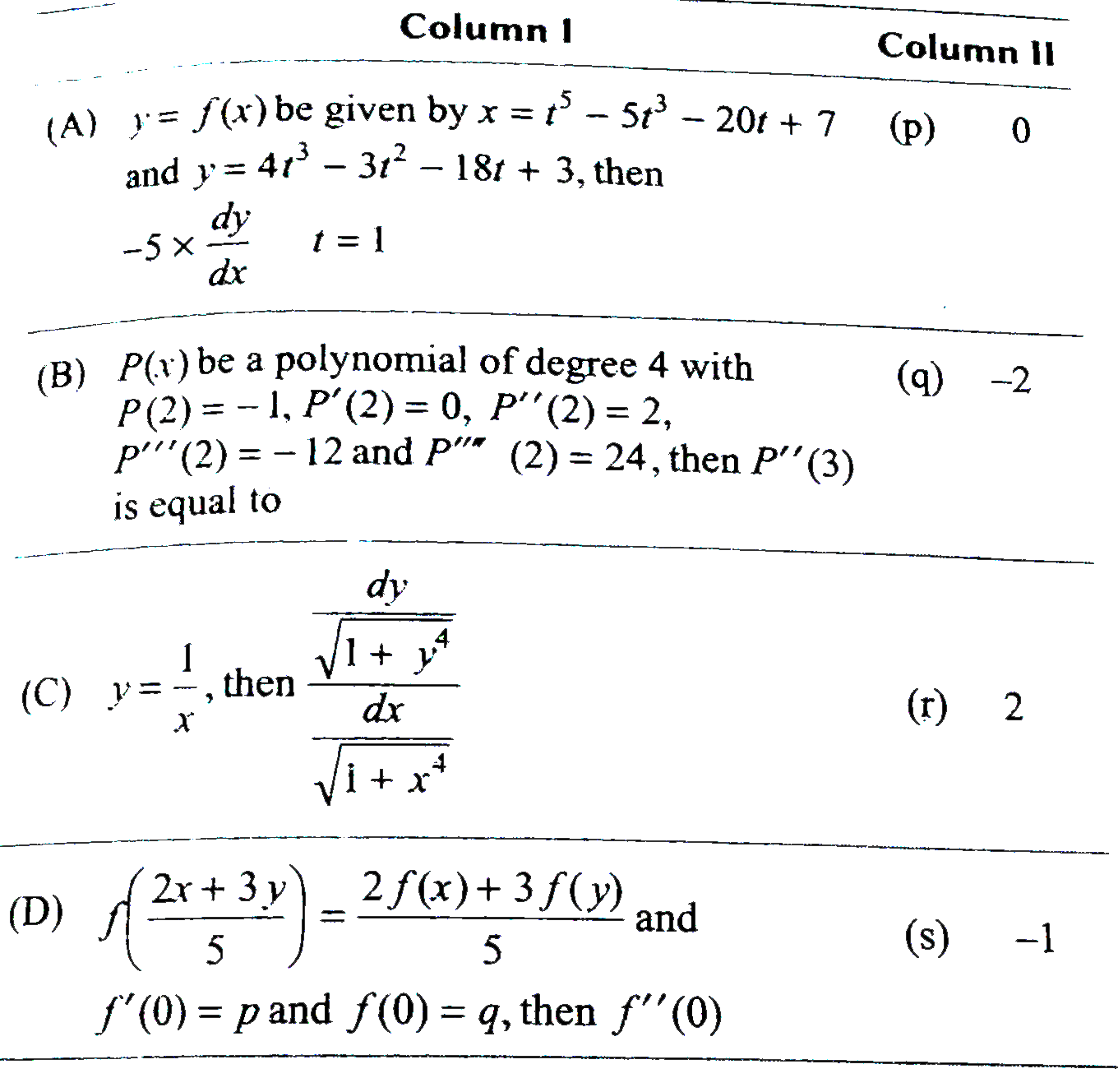Let f(x+y)−f(x)2=f(y)−12+xy, for all x,y∈R,f(x) is differentiable and f'(0)=1. Let g(x) be a derivable function at x=0 and follows the function rule g(x+yk)=g(x)+g(y)k,k∈R,k≠0,2andg'(0)=λ If the graphs of y=f(x) and y=g(x)intersect in coincident points then λ can take valuesSolution in Punjabi
-3
1
-1
4
The correct Answer is:C
Step by step video & image solution for Let (f(x+y)-f(x))/(2)=(f(y)-1)/(2)+xy, for all x,y in R,f(x) is differentiable and f'(0)=1. Let g(x) be a derivable function at x=0 and follows the function rule g((x+y)/(k))=(g(x)+g(y))/(k), k in R,k ne 0,2 and g'(0)=lambda If the graphs of y=f(x) and y=g(x)intersect in coincident points then lambda can take values by Maths experts to help you in doubts & scoring excellent marks in Class 12 exams.
Updated on:21/07/2023Topper's Solved these Questions
- DIFFERENTIATION BOOK - ARIHANT MATHSCHAPTER - DIFFERENTIATION EXERCISE - Differentiation Exercise 5:
2 Videos
- DIFFERENTIATION BOOK - ARIHANT MATHSCHAPTER - DIFFERENTIATION EXERCISE - Exercise (Subjective Type Questions)
14 Videos
- DIFFERENTIATION BOOK - ARIHANT MATHSCHAPTER - DIFFERENTIATION EXERCISE - Exercise (Statement I And Ii Type Questions)
8 Videos
- DIFFERENTIAL EQUATION BOOK - ARIHANT MATHSCHAPTER - DIFFERENTIAL EQUATION EXERCISE - Exercise (Questions Asked In Previous 13 Years Exam)
26 Videos
- DY / DX AS A RATE MEASURER AND TANGENTS, NORMALS BOOK - ARIHANT MATHSCHAPTER - DY / DX AS A RATE MEASURER AND TANGENTS, NORMALS EXERCISE - Exercise (Questions Asked In Previous 13 Years Exam)
7 Videos
Similar Questions
Match the entries between the following two columns.

View SolutionIf f(x)=x3+x2f'(1)+xf''(2)+xf''(2)+f'''(3) for all x∈R. then find f(x) independent of f'(1),f''(2)andf'''(3).
View SolutionConsider f(x)=xx2−1
Statement I Graph of f(x) is concave up for x>1.
Statement II If f(x) is concave up then f''(x)>0
View SolutionIf f:R−{−1}→Randf is differentiable function satisfies:
f((x)+f(y)+xf(y))=y+f(x)+yf(x)∀x,
y∈R−{_1} Find f(x).
View SolutionThe slope of the tangent to the curve (y−x5)2=x(1+x2)2 at the point (1,3) is.
View SolutionIf f(x-y)=f(x).g(y)-f(y).g(x) and g(x-y)=g(x).g(y)+f(x).f(y) for all x in R. If right handed derivative at x=0 exists for f(x) find the derivative of g(x) at x=0
View SolutionLet a real valued function f satisfy f(x+y)=f(x)f(y)∀x,y∈Randf(0)≠0 Then g(x)=f(x)1+[f(x)]2 is
View SolutionLet f(x+y)−f(x)2=f(y)−12+xy, for all x,y∈R,f(x) is differentiable and f'(0)=1. Let g(x) be a derivable function at x=0 and follows the function rule g(x+yk)=g(x)+g(y)k,k∈R,k≠0,2andg'(0)−λg'(0)≠0.
If the graphs of y=f(x)andy=g(x) intersect in coincident points then λ can take values
View SolutionLet f:R→R be a continous and differentiable function such that f(x+y)=f(x).F(y)∀x,y,f(x)≠0andf(0)=1andf'(0)=2.
Let f(xy)=g(x).G(y)∀x,yandg'(1)=2.g(1)≠=0
The number of values of x, where f(x)g(x):
View SolutionLet f be a continuous function on R satisfying f(x+y)=f(x)+f(y) for all x,y∈R with f(1)=2andg be a function satisfying f(x)+g(x)=ex then the value of the integral ∫10f(x)g(x)dx is
View SolutionIf f(x−y)=f(x).g(y)−f(y).g(x) and g(x−y)=g(x).g(y)+f(x).f(y) for all x∈R . If right handed derivative at x=0 exists for f(x) find the derivative of g(x) at x =0
View SolutionIf f(x−y)=f(x).g(y)−f(y).g(x) and g(x−y)=g(x).g(y)+f(x).f(y) for all x∈R . If right handed derivative at x=0 exists for f(x) find the derivative of g(x) at x =0
View Solutionमाना f(x+y)−f(x)2=f(y)−12+xy,xy∈R . f(x) अवकलनीय है तथा f(0)=1 , माना g(x), x = 0 पर अवकलनीय फलन है तथा फलनीय नियम g(x+yk)=g(x)+g(y)k(k∈R,k≠0,2) का पालन करता है। माना g'(0) = λ≠0
उपरोक्त जानकारी के आधार पर , निम्न प्रश्नों के उत्तर दीजिए :
ln(f(x)) का प्रान्त है-
View Solutionमाना f(x+y)−f(x)2=f(y)−12+xy,xy∈R . f(x) अवकलनीय है तथा f(0)=1 , माना g(x), x = 0 पर अवकलनीय फलन है तथा फलनीय नियम g(x+yk)=g(x)+g(y)k(k∈R,k≠0,2) का पालन करता है। माना g'(0) = λ≠0
उपरोक्त जानकारी के आधार पर , निम्न प्रश्नों के उत्तर दीजिए :
y=log3/4(f(x)) परिसर है -
View Solutionमाना f(x+y)−f(x)2=f(y)−12+xy,xy∈R . f(x) अवकलनीय है तथा f(0)=1 , माना g(x), x = 0 पर अवकलनीय फलन है तथा फलनीय नियम g(x+yk)=g(x)+g(y)k(k∈R,k≠0,2) का पालन करता है। माना g'(0) = λ≠0
उपरोक्त जानकारी के आधार पर , निम्न प्रश्नों के उत्तर दीजिए :
यदि y = f(x) तथा y = g(x) के आरेख संपाती बिन्दु प्रतिच्छेद करते है , तो λ का मान होगा -
View Solutionसभी x, y∈R के लिए f(x-y) = f(x) g(y) -f(y) .g(x) तथा g(x−y)=g(x).g(y)+f(x).f(y) है यदि x = 0 पर f(x) दायाँ पक्षीय अवकलज विद्यमान हो , तो x = 0 पर g(x) अवकलन ज्ञात कीजिए |
View Solution
